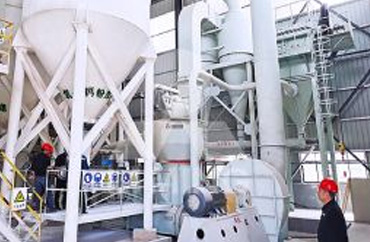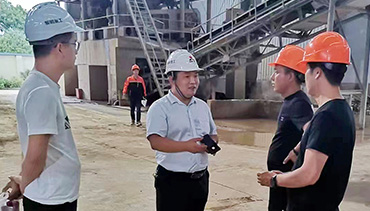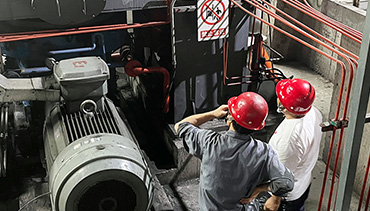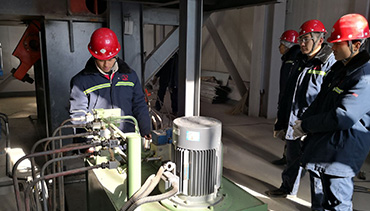

Henan LIMING Heavy Industry Science and Technology Co. LTD which mainly manufacture large and medium-sized crushing and grinding equipments was founded in 1987. It is a modern joint-stock corporation with research, manufacturing and sales together
MOBILE CRUSHERS
Stationary Crushers
Grinding Mills
Accessory Equipment
OUR
Applications
LATEST
NEWS

Limestone powder brings benefit to concrete mixing plant
Limestone Crushing Solutions for High-Capacity Aggregate Production 15/12/2025
Limestone is one of the most widely used raw materials in the aggregate and construction industries. From concrete and asphalt to cement production, efficient limestone crushing solutions play a critical role in ensuring stable supply and consistent product quality.
However, achieving high capacity and low operating cost in limestone crushing requires more than just powerful equipment. A well-matched crushing process and properly selected machines are essential for long-term success.
Based on extensive global project experience, LIMING Heavy Industry provides optimized limestone crushing solutions designed for high-capacity aggregate production.
Limestone is generally considered a medium-soft material, but its actual crushing behavior depends on several factors:
Compressive strength variations
Moisture and clay content
Abrasiveness and impurities
Required final aggregate sizes
Although limestone is easier to crush than granite or basalt, improper equipment selection can still lead to excessive fines, unstable output, and high wear costs.
Understanding material characteristics is the first step toward an efficient limestone crushing solution.
Jaw crushers are widely used as primary crushers in limestone applications due to their:
Large feed opening
Strong crushing force
Stable and reliable operation
They effectively reduce large limestone blocks into manageable sizes for secondary processing.
Depending on production requirements, limestone secondary crushing can be configured in two main ways:
Impact Crusher
Excellent particle shape
High reduction ratio
Ideal for construction aggregates
Cone Crusher
Higher capacity
Lower wear cost
Suitable for continuous, large-scale production
LIMING Heavy Industry selects secondary crushers based on capacity demand, product shape requirements, and operating cost targets.
Vibrating screens are used to:
Classify crushed limestone by size
Return oversize material for further crushing
Ensure consistent final aggregate gradation
Closed-circuit systems significantly improve product quality and reduce unnecessary re-crushing.
Typical configuration:
Jaw crusher
Impact crusher
Vibrating screen
Applications:
Local aggregate supply
Small to medium quarry operations
Typical configuration:
Jaw crusher
Cone crusher (secondary & tertiary)
Multi-deck vibrating screens
Applications:
Large-scale quarrying
Cement plant aggregate supply
Infrastructure projects
These systems are designed for continuous operation, high efficiency, and long service life.
Key optimization strategies include:
Pre-screening to remove natural fines
Proper crusher chamber selection
Optimized closed-circuit settings
Balanced feed distribution
When combined, these measures significantly improve aggregate shape, strength, and consistency.
Cost control is a major concern for aggregate producers. Effective limestone crushing solutions help reduce costs by:
Lowering energy consumption per ton
Extending wear parts lifespan
Reducing maintenance downtime
Improving finished product yield
Engineering-based system design ensures that equipment operates within optimal parameters.
With decades of experience, LIMING Heavy Industry offers:
Customized process design
Complete crushing and screening systems
Reliable equipment for harsh conditions
Professional technical support
Each limestone crushing solution is tailored to project-specific requirements, ensuring long-term efficiency and profitability.
High-capacity limestone aggregate production requires more than powerful crushers. It demands a well-designed crushing and screening solution that balances capacity, quality, and operating costs.
By combining advanced equipment with proven engineering expertise, LIMING Heavy Industry delivers limestone crushing solutions that help customers achieve stable production and sustainable growth.
Why Crushing Process Design Is Critical for Efficient Aggregate Production 11/12/2025
In modern mining and aggregate industries, equipment selection alone is no longer enough to ensure project success. The crushing process design—how different crushers and screens are configured and connected—plays a decisive role in determining production efficiency, operating costs, and final aggregate quality.
An optimized crushing process can significantly reduce energy consumption, improve particle shape, extend equipment lifespan, and maximize return on investment. In contrast, poor process design often leads to excessive wear, unstable output, and high maintenance costs.
Based on decades of engineering experience, LIMING Heavy Industry has found that a well-designed crushing system is the foundation of any successful aggregate production line.
Crushing process design refers to the overall configuration of crushing and screening stages, including:
Number of crushing stages
Type and size of crushers used at each stage
Open-circuit or closed-circuit operation
Screening configuration and recirculation logic
Material flow direction and transfer points
Rather than focusing on a single machine, process design treats the entire production line as one integrated system.
In aggregate production, the goal is to reduce raw material to target sizes efficiently, while maintaining consistent quality and minimizing energy and wear costs.
Primary crushing reduces large raw materials into manageable sizes.
Common equipment:
Jaw crusher
Gyratory crusher
Key objectives:
Handle large feed size
Ensure stable throughput
Protect downstream equipment
Secondary crushing further reduces material size and improves shape.
Common equipment:
Cone crusher
Impact crusher
Key objectives:
Increase reduction ratio
Control particle size distribution
Prepare material for final shaping
Used when higher-quality aggregates or finer sizes are required.
Common equipment:
Fine cone crusher
Vertical shaft impact crusher (VSI)
Key objectives:
Improve particle shape
Meet strict gradation requirements
Produce high-value finished aggregates
An optimized process balances these stages based on material hardness, abrasiveness, and final product requirements.
Many aggregate plants suffer from inefficiencies not because of equipment quality, but due to improper process design.
Overloading a single crusher increases power usage
Lack of pre-screening sends unnecessary fines into crushers
Incorrect closed-circuit settings cause repeated crushing
Incompatible crusher-material combinations accelerate wear
Improper reduction ratios shorten liner lifespan
Uneven feed distribution damages internal components
Bottlenecks between crushing stages
Insufficient screening capacity
Frequent blockages and material buildup
All these issues directly impact profitability and long-term plant stability.
Aggregate quality is not determined by crushers alone—it is the result of process coordination.
Impact-based crushing improves cubical shape
Excessive compression produces flaky particles
Proper staging minimizes over-crushing
Closed-circuit systems ensure consistent sizing
Screening efficiency directly affects final product quality
Optimized recirculation improves yield of target sizes
Pre-screening removes natural fines
Proper washing and screening prevent contamination
Reduced fines improve concrete and asphalt performance
A scientifically designed process helps producers meet international construction standards while maximizing usable output.
Advantages:
Simple structure
Lower initial investment
Limitations:
Poor size control
Higher risk of over-sized material
Less suitable for high-quality aggregate production
Advantages:
Precise particle size control
Higher product consistency
Improved efficiency
Limitations:
More complex system
Higher engineering requirements
For most modern aggregate plants, closed-circuit crushing systems are preferred, especially when producing construction-grade aggregates.
Screening is often underestimated, but it is just as critical as crushing.
Key roles of screening:
Remove fines before crushing
Classify materials by size
Control recirculation flow
Protect crushers from overload
An improperly sized or configured screening system can negate the advantages of high-performance crushers.
At LIMING Heavy Industry, screening equipment is selected and positioned based on real throughput calculations, not theoretical capacity alone.
Every material behaves differently:
Limestone is softer but may contain clay
Granite is hard and abrasive
Basalt requires high compression strength
River stone demands excellent shaping performance
A one-size-fits-all crushing design rarely works.
With extensive project experience across mining, quarrying, and aggregate production, LIMING Heavy Industry provides customized crushing process designs based on:
Material characteristics
Required capacity
Final product specifications
Local operating conditions
This engineering-driven approach ensures long-term efficiency and stable performance.
Efficient aggregate production starts with proper crushing process design, not just equipment selection. A well-engineered crushing system:
Reduces energy consumption
Improves aggregate quality
Lowers maintenance costs
Enhances overall plant reliability
As global demand for high-quality aggregates continues to grow, investing in optimized crushing process design is no longer optional—it is essential.
LIMING Heavy Industry remains committed to delivering complete, efficient, and sustainable crushing and screening solutions for customers worldwide.
Copper Ore Crushing & Beneficiation: Complete Process, Equipment Selection and Performance Optimization 4/12/2025
Copper ore is one of the most valuable and widely used metal mineral resources in the world. From electrical engineering and new energy storage to mechanical manufacturing and infrastructure, copper is essential due to its excellent electrical conductivity, thermal conductivity and mechanical properties. However, behind high-performance copper products lies a rigorous beneficiation process, in which crushing and grinding account for the highest energy consumption and determine the final recovery rate of copper concentrate.
This article provides a professional and SEO-friendly overview of copper ore crushing technology, including ore characteristics, process design, equipment selection and key optimization strategies for efficient plant operation.
Different types of copper ore show huge variations in hardness, abrasiveness and liberation size. Understanding ore properties is the starting point for selecting suitable crushing equipment.
Porphyry copper ore – medium hardness, stable structure, high processing capacity required.
Sandstone copper ore – brittle, easier to crush, suitable for simplified circuits.
Sulfide copper ore (chalcopyrite, bornite, chalcocite) – high hardness and abrasiveness, requiring wear-resistant liners.
Oxide copper ore – softer, less abrasive, but requires precise particle size control to improve leaching or flotation efficiency.
Liberation size (0.074–0.2 mm) is a key parameter determining how fine the ore needs to be crushed before grinding.
To achieve an optimal feed size for the grinding mill (usually ≤10–12 mm), a multi-stage crushing system is typically used.
Jaw Crusher → Cone Crusher (Secondary) → Cone Crusher (Fine) + Vibrating Screen
Advantages:
✔ Stable particle size
✔ Low over-crushing ratio
✔ High production capacity
✔ Lower energy cost for grinding
This is the mainstream solution for porphyry copper deposits in countries like Chile, Peru and Indonesia.
Jaw Crusher → Cone Crusher + Screen
Advantages:
✔ Reduced investment
✔ Simple layout
✔ Fast construction period
Designed for large feed sizes (≤900 mm)
High crushing ratio
Strong resistance to impact load
Options for heavy-duty frames and Mn18/Mn22 liners to resist abrasion
Cone crushers are the core equipment for copper ore processing.
Types include:
Multi-cylinder hydraulic cone crusher – High capacity, laminated crushing, ideal for hard sulfide ore
Single-cylinder hydraulic cone crusher – Precise CSS control, best for stable fine crushing circuits
Gyratory crusher – Suitable for ultra-large processing lines
Key considerations:
Crushing cavity type (medium, fine, super-fine)
Liner material (Mn18Cr2 / Mn22Cr2)
Hydraulic protection & automatic control
Compatibility with closed-circuit screening
A high-efficiency screening system ensures stable particle size control and protects the grinding mill from overload.
Crushing and grinding together account for 40–55% of the entire beneficiation energy consumption.
Among them, grinding consumes the most power.
Optimized crushing = lower cost per ton.
Benefits of achieving finer, uniform crushing:
✔ Reduced grinding load
✔ Lower kWh/t consumption
✔ Higher copper recovery due to improved liberation
✔ Increased plant throughput
This is especially critical for low-grade copper ore (<0.5% Cu).
Solution:
Use high-Mn alloy liners
Adopt laminated crushing cone design
Pre-screening to remove fines
Solution:
Real-time CSS adjustment
Replace coarse cavity with fine cavity
Optimize feed distribution
Solution:
Use bar-type vibrating feeder
Increase pre-screening efficiency
Apply anti-clogging chute design
Digitalization and automation are the main trends in copper beneficiation plants.
Real-time monitoring of pressure, power and chamber load
Automatic CSS control for stable product size
AI-driven optimization for crushing–grinding integration
Predictive maintenance for liners and bearings
This helps achieve higher uptime (≥95%) and lower operational cost.
Copper ore beneficiation is a highly technical process, and crushing plays a decisive role in energy consumption, product size, and final recovery rate. Through proper process design, equipment selection and intelligent optimization, mining enterprises can achieve:
Higher ore processing capacity
Lower unit energy cost
Better grinding efficiency
Higher copper concentrate recovery
Safer and more stable production
Why
Choose Us

Passionate

Professional

Support
